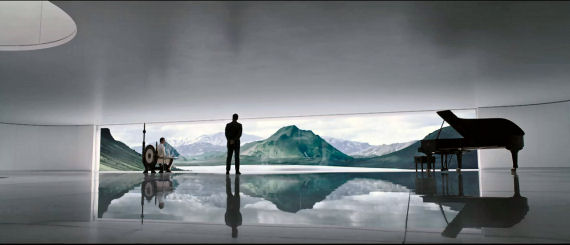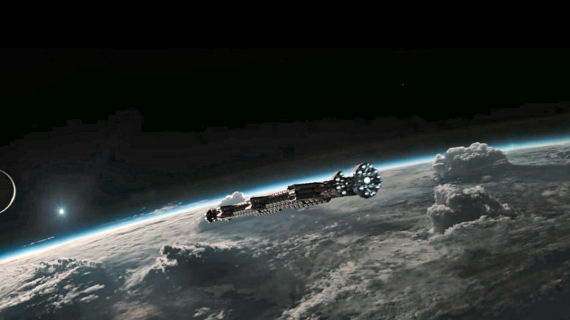
Oddly enough, I haven’t seen the image in Figure 1 in the movie itself, unless I blinked and missed it. This will be more in the way of a “pro forma” column, because I have to have something in, rather than my usual long-winded one, for reasons of time. I have under two weeks to get my office cleaned out (see my “divest” comments in an earlier column), and I have a ways to go. But I owe you guys a column, so here ‘tis.
Of course, when you wait a few weeks to see a new movie—even one which is part of a long-running franchise—you will have already heard good and bad things about it, including spoilers. And this movie is extremely hard to review without spoilers, as there is a lot going on in it. So if you haven’t seen Alien: Covenant yet, and you don’t want spoilers, maybe you should skip this week, just in case I say something you don’t want to know about; or at least wait until you’ve seen the movie to read it. I don’t generally mind spoilers myself, as I have the mystic ability—that I learned in the Himalayas—to cloud my own mind. My wife, however, hates spoilers a lot, so I generally try not to give them. This week will be an exception. So moving on to the film itself, let me give you my review, or at least my impression.

The film opens on an eye; then the camera pulls back and we see it’s David’s eye—though we don’t know it yet. If you haven’t seen the previous movie (Prometheus) you won’t know about David (Michael Fassbender). What we see is what appears to be a person in a white jumpsuit, sitting in a chair; there’s another man dressed in dark clothing sitting in another, rather more ornate chair. The dark-clothed person tells the other to describe what he sees; we see what he sees, but we don’t have the cultural referents until he speaks; we see (Figure 2) a large, barely-furnished room, with a wide-screen view—we assume this is a floor-to-ceiling window or set of windows—of some mountains. The figure in white describes his surroundings: he sees an Andretti Throne Chair, he sees a Steinway concert grand piano, he sees a painting of the Nativity by Piero della Francesca. The other man tells him “ambulate,” and the man in white gets up and walks (though why not just “walk,” I don’t know); he is told to play something by Wagner, and he plays the “Gods’ entrance into Valhalla” from Das Rheingold. The man in black tells the other “I am your father,” and that the man in white is “perfect.” The man in black, whom we later know to be Peter Weyland (Guy Pierce) (I had to look at the credits to be sure if it was Weyland), tells the other “I created you; I am your father.” The one in white is asked what his name is, and he “ambulates” over to a life-size statue of Michaelangelo’s David (who knows, Weyland is rich; and it’s 2104; maybe it’s the real thing). And the android, for now we know what he is, says “David. My name is David.” Then a real subtle scene begins—both a foreshadowing and a reminder to David that he is not a real person and must serve—and David is told (twice!) to pour the tea that is sitting at Weyland’s right hand. At this point we’re not sure what’s going on, because those of us who saw Prometheus last saw David in two pieces—his head and his body separate from each other—on the floor of the alien spaceship. Cut to a 2001-ish scene of a long, very industrial-looking (in the architectural sense) spaceship against a starry background; we learn that it is the colony ship Covenant, and it carries 2000 colonists and 1200 embryos (we aren’t told what kind of embryos) and is on a multi-year voyage to the planet Aurigae 6.

There is a figure in a hoodie onscreen, and we hear “Walter, it’s time to recharge the energy systems” (something like that) and we see that Walter is an Artificial Person (Bishop, in Aliens, said they prefer to be called that rather than androids) who looks exactly like David. Walter tells Mother (since these are all prequels to Alien, I believe, I wonder why Mother speaks in this movie, but not in the first; i.e., later, movie?) to deploy the recharging sails, which she does. As he is checking various things, he takes an embryo from the racks of frozen embryos (it looks human, but then, as they say, “ontology recapitulates phylogeny”—in other words many embryos look alike at one stage or another) and puts it in a Biohazard container. (This sequence is never referred to again, by the way.) He’s interrupted by a warning from Mother, who says there is a neutrino blast from a nearby sun (nifty computer graphics from the year 2017 are on a nearby screen) that could cause a power overload and damage the ship; he begins running to the control room as the “neutrino blast” hits the “solar sails,” damaging them, several deep sleep containers are knocked off their racks, and he tells Mother to emergency-wake the crew. As he gets to the control room and starts extinguishing the electrical fires from the overload, the crew are dealing with other issues: the captain’s sleep capsule won’t open, and the captain is burned to death. And from here things start to fall apart. (Sorry, can’t find the “sarcasm” or “irony” fonts on this thing.)
The second-in-command, Oram (Billy Crudup), who is ill-prepared to be captain—they passed him over for command in favour of the now-dead captain (James Franco) is—apparently alone in the crew—a man of “faith,” though that faith is not ever explored. They’ve lost 47 colonists and a number of embryos, and are still “8 recharges” away from Aurigae 6; it appears they charge their energy systems and then do a year-long “jump,” though how that works escapes me. While they’re fixing everything up, a strange signal is received on the pilot’s helmet from a nearby planet; it’s almost indecipherable, except that someone appears to be singing John Denver’s “Take Me Home, Country Roads.” Upon further investigation, the planet that the signal appears to come from is in the “Goldilocks Zone,” meaning it’s habitable, and the new captain decides they should explore it to see if maybe it will be better for them than Aurigae 6. They arrive at the new planet, which is wracked by “ion storms,” meaning once the lander goes down it will be hard for them to communicate with it, but apparently time’s a-wastin’, so instead of waiting out the storms, they decide to go ahead and land… and here’s where my real problems with this film began.

**Some spoilers here!***
Okay, instead of landing on dry land, the pilot, Tennessee (“T” for short) (Danny McBride)—and apparently there is only one pilot in the whole crew—lands partially in the water (Figure 4). They have to walk up a mountain to get to where the signal’s coming from. But here’s the kicker—they don’t show them sampling the air before they just open the landing ramp and all file out—nobody wearing helmets! Yes, they could sample the atmosphere before they opened the ramp; they could even check for bacteria and so on, but all they would have had to do is put a line in the script about it!
As they hike towards the signal, a biologist (the pilot’s wife) decides to hang back and one crewman is left to guard her; he decides to have a cigarette (!)—really? Heck, even today, smokers are dying out!—and sits down on a convenient log, squashing some plant life as he steps. As he does so, a swarm of little glittery things come out of the plant and eventually head into his ear. Yes, they’re on a planet where you have seen wheat—an Earth plant—and that’s not even a danger signal to them… here they are umpty-light-years from home, and there’s wheat there? Someone should have been waving his arms and shouting “Danger, Will Robinson!” Then they don’t even watch where they walk. When the rest of the landing party arrives at the alien ship, one of them sees some little puffballs on the ground and squishes one, releasing a swarm of—you guessed it!—little glittery things up and into his nose. While these guys—except for puffball guy, who’s guarding outside—are exploring the alien ship, they accidentally trigger the control panel and the hologram of (I’m guessing) Dr. Elizabeth Shaw (Noomi Rapace), whom we last saw watching her ship take off (in Prometheus) and crash into the alien ship, stranding her on Prometheus, singing “Take Me Home, etc.”

Meanwhile the sick crewman (the one who stepped on the plants) has been coughing up blood and so on, so the pilot’s wife drags him back to the ship where he… surprise! …has an alien (a “xenomorph”), one we’ve not seen before, come out of his back! (Figure 5) and start chasing her around the lander. In a surprising turn, she actually grabs a gun and goes after the alien—but she’s shooting indiscriminately inside the lander and blows it up. That’s right, she blows up the frickin’ lander with her (and the alien) inside! (I was reminded of Jeff Goldblum’s quote from Jurassic Park: “Oh, yeah. Oooh, ahhh, that’s how it always starts. Then later there’s running and screaming.”)
Let me cut to the chase, as I promised this would be short-ish. If anyone in this movie acted with a lick of common sense, this movie would be very short and not very interesting. It’s only when they behave stupidly that there’s action and something that Ridley Scott hopes is interesting to the viewer. And just about everything, including—no, especially—the ending, is pretty darned predictable! There is about a 15-minute segment in the latter half of the movie where you’re rooting for the late captain’s widow, Daniels (Katherine Waterston), as she fights a big xenomorph on the outside of the lander. But really, it’s very pro forma, as you’re sure she’s gonna win. But it’s the only part that felt like Alien to me. Unless you’re a completist, I advise you to wait for whatever method of watching this—like cable TV—is cheapest. I give it two thingamajigs, and that’s because I’m feeling kind today. ¤¤
If you feel like it, please comment on this column. You can comment here; or you can comment on my Facebook page, or in the several Facebook groups where I publish a link to this column. Your comments are all welcome, and don’t feel that you need to agree with me to comment. As always, my opinion is my own, and doesn’t necessarily reflect the views of Amazing Stories or its owners, editors, publishers or other columnists. See you next week!











We are very like minded. I like your comprehensive “what on earth?” review! https://writerlesleydonaldson.com/alien-covenant-review
Thanks. I did, however, cut the review short and leave out the ultimate (but ultimately very predictable) ending spoiler. Supposed to be a shocker, but no.
Alien gets off the planet. Shocking. Android turns on humans. Shocking.
If Elizabeth had been hybridized into some kind of enslaved Alien queen, that would interesting.
If anything had happened that was NOT predictable, that would have been interesting. Thanks for your comments, Lesley!